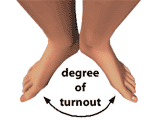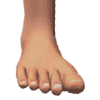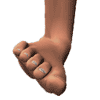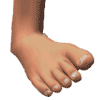Positions of the Feet
There are many ways to describe foot positioning. Some methods involve describing
the angle or position of a single foot, while others describe the positions or
angles of the feet relative to each other. The following article will give you a
basic understanding of the most common methods for describing the various positions
of the feet.
The most fundamental method is to refer to one of five basic foot positions:

First Position
Feet together.

Second Position
Feet apart, side by side.

Third Position
Feet together, heel to instep.

Fourth Position
Feet apart, one foot in front of the other.

Fifth Position
Feet together, one foot in front of the other, toe to heel.
These five foot positions were originally established for the teaching of
ballet, and as a result, are not always ideally suited for ballroom dancing.
You are more likely to hear a ballroom dance teacher say "Step forward"
than "Take fourth position", simply because ballroom dancers prefer
to speak in terms of directions of movement. Nonetheless, instructors will refer
to these positions on occasion (especially 5th position), so you should get to
know them.
Turnout
Turning Out is the process of rotating the feet outward to an angle, so that the
toes point away from each other. The angle that results between the feet is known
as the degree of turnout. When the feet are held without any turnout, they are
referred to as parallel.

Feet parallel.
|

Feet turned out.
|
For Smooth and Standard style ballroom dancing, the feet are normally held parallel.
Some turnout is used in very specific situations, as outlined in the technical
breakdown of a figure. When turnout is not specified, it is assumed that feet are
parallel.
Turnout in the Latin and Rhythm dances is recommended for the majority of situations.
The desirable amount of turnout is somewhere between 45 and 90 degrees. Ballet dancers
strive to achieve turnout entirely through the rotation of the legs so that the knees
always point to the same angle as the toes. Latin dancers, on the other hand, will
allow the feet to turn out at the ankles; Thus the knees, when bent, point straight
forward (or even roll slightly inward) in spite of the turned-out angle of the feet.
Supanation and Pronation
The rolling of the foot toward the inside or outside edge is known as pronation
and supination, respectively. It is very important to become aware of these positions,
even if you don't remember their names.

Normal position of foot. |

Pronated foot. |

Supanated or
"Sickled" foot. |
The image on the left shows the normal position of the foot. The image at center shows
the pronated position of the foot, with the inside edge to the floor. This position
is used quite frequently in the Latin and Rhythm styles of ballroom dancing. When the
body weight is held over the outside edge, the foot has rolled out into a supinated
position (more commonly referred to as "sickled"), as shown in the image on
the right. A sickled position is undesirable, and should be avoided at all times.










